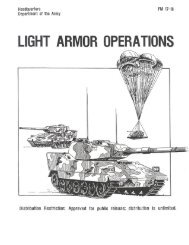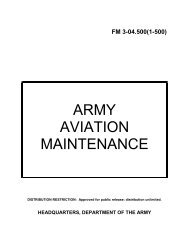fm 44-100 us army air and missile defense operations
fm 44-100 us army air and missile defense operations
fm 44-100 us army air and missile defense operations
You also want an ePaper? Increase the reach of your titles
YUMPU automatically turns print PDFs into web optimized ePapers that Google loves.
FM <strong>44</strong>-<strong>100</strong><br />
terminals were developed for <strong>us</strong>e at corps <strong>and</strong> higher headquarters. The<br />
evolution of the TENCAP systems has made it feasible to deploy certain<br />
systems to echelons below corps also. The request <strong>and</strong> dissemination process,<br />
system capabilities, <strong>and</strong> specific applications can be found in the Joint<br />
Tactical Exploitation of National Capabilities (J-TENS) manual.<br />
WEATHER, TERRAIN AND ENVIRONMENTAL MONITORING<br />
C-20. Environmental monitoring consists of gathering weather <strong>and</strong> terrain<br />
data. Three satellite systems are the primary contributors.<br />
Weather<br />
C-21. Weather has a significant impact on the conduct of tactical <strong>operations</strong><br />
in terms of visibility, temperature, <strong>and</strong> maneuverability. Electro-optically<br />
guided weapons <strong>and</strong> other weapons are particularly sensitive to weather<br />
conditions along their flight path. Space systems provide detailed information<br />
on the current atmospheric conditions over a wide area, to include areas<br />
where there are few weather sensors or where political <strong>and</strong> military<br />
considerations restrict the gathering of weather data. Satellite imagery <strong>and</strong><br />
data also support the preparation of accurate weather forecasts. The Army<br />
requires both imagery <strong>and</strong> vertical profile data; for example, atmospheric<br />
conditions from both military <strong>and</strong> civil weather satellites.<br />
Defense Meterological Satellite Program<br />
C-22. The Defense Meteorological Satellite Program (DMSP) provides<br />
worldwide visible <strong>and</strong> infrared cloud imagery <strong>and</strong> other meteorological,<br />
oceanographic, <strong>and</strong> space environmental data for the Department of Defense.<br />
Normally, two DMSP satellites are maintained in sun-synchrono<strong>us</strong>, near<br />
polar, 833 kilometers (518 miles) high circular orbit. Each satellite provides<br />
coverage of the entire earth every 12 hours. With two satellites, a specific<br />
area is observed once every four to eight hours. DMSP satellites carry a<br />
variety of sensors which collect data of an area up to 2,960 kilometers (1,839<br />
miles) wide. The primary sensor is the Operational Linescan System (OLS)<br />
which provides cloud imagery in visible <strong>and</strong> infrared b<strong>and</strong>s. In the fine mode,<br />
resolution of images of areas designated by DMSP control can be 0.6<br />
kilometers. All other areas are imaged in the smooth mode, which provides a<br />
resolution of 2.8 kilometers in daylight or 3.5 kilometers at night. In addition<br />
to the OLS, DMSP satellites have a microwave sensor that provides a vertical<br />
temperature profile of the atmosphere. Each satellite also has sensors to<br />
measure the space environment <strong>and</strong> the upper reaches of the ionosphere.<br />
Data transmitted by the DMSP satellites is encrypted. DMSP is controlled by<br />
the Air Force Space Comm<strong>and</strong>.<br />
Terrain<br />
C-23. The human eye sees light across a region of the electromagnetic<br />
spectrum known as the "visible" region. Human vision presents an image as a<br />
color rendition of the world, visible under typical conditions. A spectral<br />
imaging system can be designed to receive in narrow b<strong>and</strong>s, for example, only<br />
green. A multispectral imager is one that "sees" in several specific b<strong>and</strong>s<br />
(wavelengths) simultaneo<strong>us</strong>ly <strong>and</strong> stores the information as separate images.<br />
C-5











